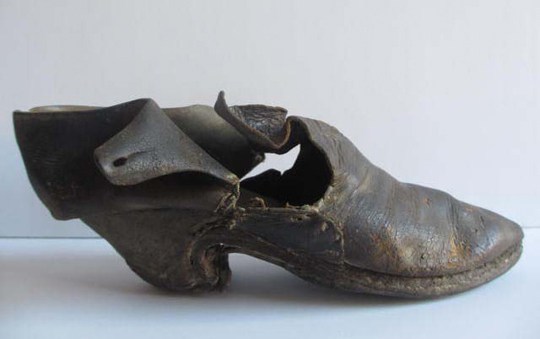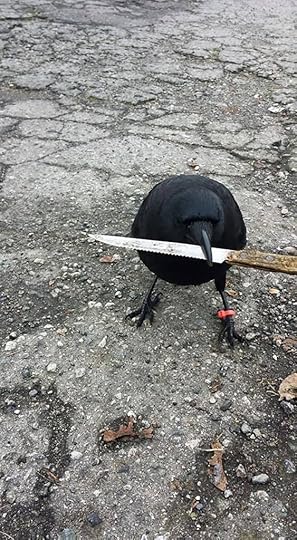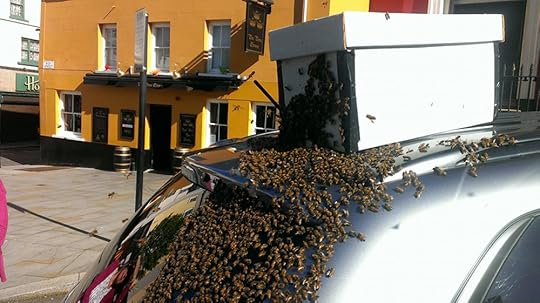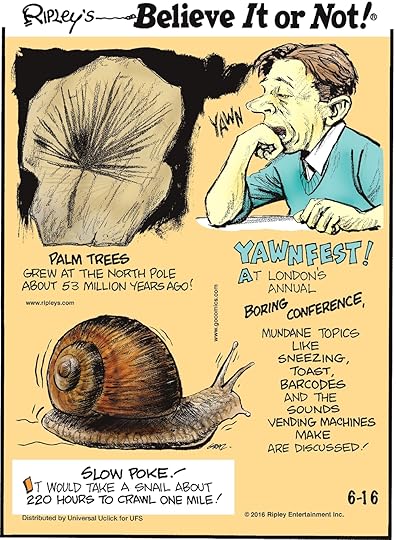Ripley Entertainment Inc.'s Blog, page 479
June 16, 2016
Witness the Amazing Stock-Picking Cat
Featured in Ripley's Believe It or Not!

In 2012, an experiment was held in which professional Stockbrokers chose stocks against a cat to which who was better, the cat won.
The professionals chose stocks based on their years of experience
Orlando the cat chose by batting his favorite toy onto a grid of number that represented different companies
The professionals were in the lead for most of the year
From September through the end of the year, however, Orlando’s portfolio increased by an average of 4.2%
In the end, the professionals had earned £5,176.60 compared to Orlando’s £5,542.60
MINI BION
“BIONs” – short for Believe It or Not – is the word we use at Ripley’s to refer to anything that is unbelievable and worthy to become part of Ripley’s lore and collection.
The Star-Nosed Mole Has a Weird Tentacled Snout
Featured in Ripley's Believe It or Not!

The Star-Nosed Mole’s nose features 22, fully articulated, tentacles that can grab and hold prey.
The mole’s nose is the most sensitive touch organ in the world
It’s smaller than a fingertip, but has more touch nerves than an entire human hand
Because they’re blind, the Star-nosed mole uses its nose to navigate the world like most animals use their eyes
The mole is also the only mammal capable of using its nose to smell underwater
MINI BION
“BIONs” – short for Believe It or Not – is the word we use at Ripley’s to refer to anything that is unbelievable and worthy to become part of Ripley’s lore and collection.
CARTOON 06-16-2016
June 15, 2016
England’s Mysterious Concealed Shoe Index
Featured in Ripley's Believe It or Not!

Why would someone in 16th-century England hide an old worn shoe in the floorboards of their home? What is a child’s boot doing hidden in the brickwork of a fireplace?
These are the questions the concealed shoe index is trying to answer. Simply, the index is a list compilation of concealed shoes found and reported.
What we know:
The shoes are almost always worn out
There is often only a single shoe—the match is missing
Many of the shoes are those of children
Most shoes were placed during construction
Workers have been known to replace concealed shoes if they find them while renovating
The practice dates back to the 1500s
Why one shoe? One reason that single shoes were used was that it kept evil spirits from stealing them. Surely a demon wouldn’t walk around in one shoe. Thus, the shoe’s protection would stay in place.

Concealed shoe collection, Northampton Museum
Starting the Index
According to the Northampton Museum, concealed shoes have been invaluable in studying what common people were wearing hundreds of years ago.
The Northampton Museum in England created the concealed shoe index, and there are approximately 1,900 finds on the index today. The index doesn’t just include shoes in the UK though, but concealed shoes have been reported in the US, Canada, France, Spain, and Poland.
The museum started the index in the late 1950s after the Head of the Shoe and Boot department, John Thornton, realized that some of the shoes they received were found under mysterious circumstances.
Museum historians wondered why children’s boots would be hidden atop a chimney. Their curiosity eventually led to the creation of the index.

Woman’s 16th-cnetury concealed shoe
Where are shoes found?
The shoes show up in all manner of homes, including cottages, mansions, farms, palaces, pubs, cathedrals, hospitals, schools, and even Charlie Chaplin’s old movie studio.
Most shoes are found by workmen, and likely go unreported, but the museum has also found that many property owners refuse to allow the shoes to leave their residence.
Other theories
While the prevailing theory is that hiding shoes was a superstitious practice meant to ward off evil, a few other theories have been floated.
Shoes have often been associated with fertility in England. Practices include attaching shoes to wedding cars, throwing a shoe after a bride, and an odd practice called “smickling”.
Smickling was the practice of childless women trying on the shoes of a woman who had just given birth in order to enhance their own fertility.
Another curious association between shoes and fertility is ascribed to the nursery rhyme “There was an old woman who lived in a shoe…”
CARTOON 06-15-2016
June 14, 2016
The Water’s Rough, But He’ll Keep Rowing
Featured in Ripley's Believe It or Not!
We bring you another update from Stein Hoff during his cross-Atlantic row.
This row is certainly about highs and lows. I had a scary incident already on May 16th, the 2nd day at sea, but what happened on Day 26, last Thursday 9th June, is the worst so far.
It was very windy and rough all day, but sunny, and we were making great mileage just drifting. I got caught unawares. As the wind piped up at sunset, a huge breaker knocked us down from port side. I was holding the sat phone with one hand reading a text that just ticked in and had just added boiling water and an egg to a dehydrated meal. Suddenly, I’m thrown over to starboard and see water halfway across the hatch and squirting in. Also entering around the compass and from the top ventilator. Got the hatch and ventilator properly shut while feeling as if I were in a shower, and then threw myself to the other side waiting for the boat to get up. That seemed to take so long! But eventually, the hatch rose over the water.
I got out and leaned far over to port as the boat slowly rose further. Two buckets of water now outside the boat and all that water caught inside the gunnel held her because no large amounts had got into any of the five the storage compartments below starboard deck. Then I got out the sea anchor (SA) as quickly as I could and after about 15 min, Fox II finally had her nose facing the gale, and I knew we were reasonably safe. And I was soaked, cold and frightened! All my clothes except two woolen long-johns and the survival suit were soaked, all my bedding also badly affected. The suit took awhile to get on but soon stopped my shivering. Hours of sorting, cleaning, rinsing followed, draining water from the battery hold below the bunk, etc. Self-reproach, worries. Never thought to give up, though! Next 2 days were spent lying to the SA. Saturday became sunny, made lots of water, cleaned the entire cabin inside, rinsed and dried as many clothes as possible. Cut off bottom and top of the mattress and helped by plastic and canvas have a reasonable bed again. And bits of pasta is no longer falling off the ceiling!
I have made some expensive lessons, have learned to show more respect for nature in these treacherous waters and have gained an even higher admiration for Harbo & Samuelsen’s incredible voyage. No wonder Ripley was impressed! Optimistic greetings from Stein, the slow, lone Atlantic rower at 40 58 N, 061 23 W, about 600 n miles from the start on day 31.
The Manchineel Tree is the Deadliest Tree in the World
Featured in Ripley's Believe It or Not!

Per Guinness, the Manchineel Tree has taken the title of world’s most dangerous tree for the sixth year in a row.
The leaves and fruit of the tree superficially resemble an apple tree
The tree’s Spanish name, manzanita de la muerte, means “Little apple of death”
One bite of the tree’s fruit can cause abdominal pain, vomiting, bleeding, or death
Touching the tree’s sap, even if it’s been diluted, can cause blistering
Don’t try burning the tree either because the smoke can cause blindness
MINI BION
“BIONs” – short for Believe It or Not – is the word we use at Ripley’s to refer to anything that is unbelievable and worthy to become part of Ripley’s lore and collection.
Source: The Manchineel Tree is the Deadliest Tree in the World
Clever Crow Confounds Crime Scene
Featured in Ripley's Believe It or Not!

If you haven’t heard of him before, Canuck the Crow is quickly becoming a local celebrity in the East Vancouver area. It’s a big area, but he can fly after all.
Canuck was found as a baby after he’d fallen from a tree. He was nursed back to health until he learned to fly and was released into the world. But the thing is, he never really left.
After that, he met Shawn, and the two have been fast friends ever since.
The two of them have a daily routine, and spend a lot of time together, but when Canuck isn’t with his best buddy, he flies off on his own and has adventures with other people. The orange zip tie on his leg marks him as having had contact with humans and has become the quick way for people to recognize who they’re interacting with.
People in the area are always on the lookout for their feathered friend, and whenever he’s spotted, they’ll take pictures to be posted on Canuck’s Facebook page.
But sometimes when he’s away from Shawn, Canuck the Crow can get into a spot of trouble.
A Crow’s Life of Crime
Early one morning, police were called to the scene of a car in flames. There was a man on the scene who had a knife.
The cops had no choice but to shoot him in the leg to apprehend him safely. When they did so, he dropped the knife. Not one to miss his moment, Canuck swooped in and picked it up and flew off with it.

Credit: Canuck and I Facebook page
It should be noted that the knife Canuck is holding in these images is not the knife he illegally stole from an active crime scene. They were taken by Shawn months before the incident in question. But they do set the precedent for a bird with a fondness for weapons.
Actually, the truth is Canuck is just a normal and curious crow, and he’s a big fan of picking up a lot of different objects.

Credit: Canuck and I Facebook page
To his credit, Canuck dropped the knife quickly, and the police were able to recover it. No one was injured, and the investigation wasn’t hampered at all.
If you’re ever in his neck of the woods, keep an eye out for Canuck the Crow.
CARTOON 06-14-2016
June 13, 2016
A Swarm of Bees Follow a Car for Two Days
Featured in Ripley's Believe It or Not!

Carol Howarth was planning on just having a simple and normal day in May. She headed to a nature reserve to spend some time communing with nature. When she was done, she got in her car and headed back into civilization. She stopped at a store, as one will do, and then returned to find a swarm of bees all around her car.
It’s not the sight one wants to be faced with after a little afternoon shopping. What exactly does one do with thousands of bees on and around the trunk of one’s car? With bees going extinct, getting a big can of bug spray isn’t really the best option.
Luckily, Pembrokeshire Coast National Park ranger Tom Moses was on the case.

Credit: TOM MOSES/FACEBOOK
The Swarm
People had stopped to take pictures and marvel at the sight of the bees on the car’s trunk. Tom Moses noticed and went in for a closer look. Using his connections through work, he called two members of the Pembrokeshire Beekeepers’ Association to help.
I was a little bit concerned, with it being in the middle of town outside a pub, that someone might do something stupid and get hurt or do something stupid and hurt the bees
The solution seems more simple than you might assume. The beekeepers swept some of the bees into a box, and then just waited for the others to follow suit.

Credit: TOM MOSES/FACEBOOK
Thinking the problem had been taken care of, Howarth headed home. She woke up the next day to find the bees had returned and were congregating at the same point on her car.
The theory behind this behavior is that the queen of the hive somehow ended up in the car’s trunk, and when the bees were removed the first time, they missed the queen, leading to them coming back the next day.
It is possible the queen had been attracted to something in the car – perhaps a sweet or food in the car. The swarm of around 20,000 had followed her and were sat around on the boot of the car. -Roger Burns, Pembrokeshire Beekeepers
The bees were removed after the second day, and no further incident has occurred, but if they do come back, Howarth may just have to give up and buy a new car.
Ripley Entertainment Inc.'s Blog
- Ripley Entertainment Inc.'s profile
- 52 followers






